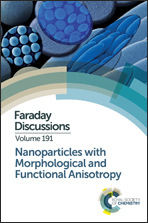Optical anisotropy and sign reversal in layer-by-layer assembled films from chiral nanoparticles†
Abstract
Chiral anisotropy and related optical effects at the nanoscale represent some of the most dynamic areas of nanomaterials today. Translation of optical activity of chiral semiconductor and metallic nanoparticles (NPs) into optoelectronic devices requires preparation of thin films from chiral NPs on both flat and curved surfaces. In this paper we demonstrate that chiral NP films can be made via layer-by-layer assembly (LBL) using negatively charged chiral CdS NPs, stabilized by D- and L-cysteine and positively charged polyelectrolytes, as building blocks. LBL coatings from NPs combine simplicity of preparation and strong optical activity. Circular extinction measurements using circular dichroism instruments indicate that the film possess four chiroptical bands at 280, 320, 350, and 390 nm. The latter two bands at 390 and 350 nm are associated with the band gap transitions (chiral excitons), while the former two are attributed to transitions involving surface ligands. When NPs are assembled in LBL films, the rotatory activity and the sign for circular extinction associated with the electronic transition in the inorganic core of the NPs is conserved. However, this is not true for circular extinction bands at short wavelengths: the sign of the rotatory optical activity is reversed. This effect is attributed to the change of the conformation of surface ligands in the polyelectrolyte matrix, which was confirmed both by semi-empirical and density functional (DFT) quantum mechanical calculations. Circular dichroism spectra calculated using a DFT algorithm closely match the experimental spectra of CdS NPs. These findings indicate that the spectroscopic methods sensitive to chirality of the surface ligands can be used to investigate fine structural changes in the surface layer of nanocolloids. Strong rotatory optical activity of nanostructured semiconductor films opens the possibilities for new polarization-based optical devices.
- This article is part of the themed collections: Celebrating our 2018 prize and award winners and Nanoparticles with Morphological and Functional Anisotropy

 Please wait while we load your content...
Please wait while we load your content...